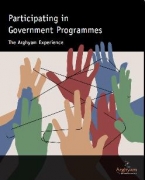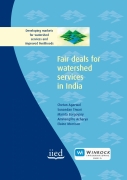Amitangshu Acharya
In conversation with nature
Posted on 15 Apr, 2019 05:42 PM“There is a special type of black ant that is visible just before (and during) the onset of heavy rains.

Saltscapes - Dholavira, Gujarat - A guest post by Amitangshu Acharya and Ayan Ghosh
Posted on 27 Dec, 2010 11:41 PMGuest Post: Text by Amitangshu Acharya, Photographs by Ayan Ghosh
Kachchh – a brilliant halfway between a turmeric yellow Rajasthan and the emerald green Sahyadris – offers an upside down version of life. It tells you that seeds of life and civilisation are often hidden beneath the sands of time in inhospitable terrains.
Umiam Lake and Shillong's Rivers: In spite of the odds – An advocacy flyer by Arghyam and Peoples Learning Centre
Posted on 22 Dec, 2010 11:01 PM This advocacy flyer by Arghyam and Peoples Learning Centre (PLC) Shillong highlights some of the main problems, action underway and potential solutions to cleaning up the water bodies of Shillong. It deals with the expanding human habitats and escalating socio-economic activities around the rivers Umkrah and Umshyrpi that flow through Shillong leading to their choking with sewage and pollution. This wastewater eventually enters Lake Umiam, which is a reservoir for hydro-electric power.
This advocacy flyer by Arghyam and Peoples Learning Centre (PLC) Shillong highlights some of the main problems, action underway and potential solutions to cleaning up the water bodies of Shillong. It deals with the expanding human habitats and escalating socio-economic activities around the rivers Umkrah and Umshyrpi that flow through Shillong leading to their choking with sewage and pollution. This wastewater eventually enters Lake Umiam, which is a reservoir for hydro-electric power.
PLC is a non-profit organisation that works towards promoting knowledge on equity and rights, and is a platform for facilitating interdisciplinary dialogues between stakeholders in key developmental issues. Arghyam supports PLC in engaging with decision makes as well as citizens in order to create public opinion about river and lake pollution, and promote catchment friendly practices.
Participating in Government Programmes - The Arghyam Experience (2010)
Posted on 21 May, 2010 01:25 PM Arghyam, a civil society organisation working on water issues since 2005, has participated in drinking water programmes involving State Governments since its inception, either directly or by partnering with local Civil Society Organisations (CSOs).
Arghyam, a civil society organisation working on water issues since 2005, has participated in drinking water programmes involving State Governments since its inception, either directly or by partnering with local Civil Society Organisations (CSOs).
This publication documents Arghyam's and its partners' collective experiences in participating in these Government programmes and puts forward key learnings and challenges.
The various programmes include - Sachethana, a school rooftop rainwater harvesting programme, and Suvarnajala, a flouride mitigation programme, both in Karnataka; Pani Thiye Panjo, a decentralised drinking water management programme in Gujarat; and Mazhapolima, an open-well recharge programme in Kerala.
Developing markets for watershed services and improved livelihoods: Fair deals for watershed services in India - An IIED research paper
Posted on 07 May, 2010 10:51 PM The report presents field experiences and lessons in developing Incentive-based Mechanisms (IBMs) for watershed protection services and improved livelihoods at micro and macro-scales, derived from an action-learning project in India at three locations in the states of Himachal Pradesh (HP) and Madhya Pradesh (MP).
The report presents field experiences and lessons in developing Incentive-based Mechanisms (IBMs) for watershed protection services and improved livelihoods at micro and macro-scales, derived from an action-learning project in India at three locations in the states of Himachal Pradesh (HP) and Madhya Pradesh (MP).
An inter-village transaction was facilitated at one site (the Kuhan micro-catchment in HP), while at the second site (Suan micro-catchment in HP) a transaction failed to materialize despite initial interest. At the third site in MP, there was interest in undertaking a transaction between the city of Bhopal and the catchment of its lake, the Bhoj Wetlands.
The action research has yielded insights into the role of hydrological information, types of incentive mechanisms, the importance of institutions and the implementation of IBMs.
Persian wheel : The water lifting device in Kolar, Karnataka
Posted on 22 Jan, 2008 11:26 PM What exactly is a Persian wheel? Also known as Rahat (in Urdu), it's a simple water lifting device, where a number of small pots are attached to a long chain. Two gear wheels make up the system and as the first one is revolved, the pots each dip and swallow water from the well and soon after pours itself out to a metallic shaft which in turns empties into an intricate network of troughs that distributes water adequately through the cropped area. It is believed that the technology originated in Egypt and as world shrunk through extensive trading, it spread to India and China.
New water management system in Cape Town, South Africa ensures that everybody gets 6000 litres free every month as a right
Posted on 10 Dec, 2007 11:53 AMSouth Africa: New Water Management System in Cape BuaNews (Tshwane) 5 December 2007 Cape Town The City of Cape Town is introducing a new water demand management system for its residents. It consists of a water management device, which is installed in residents' houses, and a central control team in the City administration that regulates the functioning of these devices with the help of a computer set up. "This system will help our customers to save water and to manage their monthly water bills, and it will help the city to manage debt," the city council said. It will also help residents to identify any leaks and have them fixed, instead of running up a huge water bill and then being unable to pay.